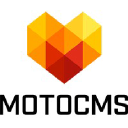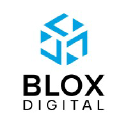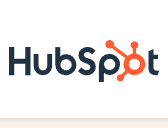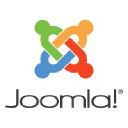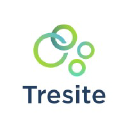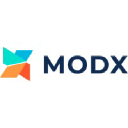
Strapi
What is Strapi?
Strapi is an open-source headless CMS that enables developers to build and manage APIs quickly and easily. It provides a flexible and customizable platform for creating and delivering structured content across various devices and channels.
Key Features of Strapi
- API Creation: Strapi allows developers to create APIs rapidly using its intuitive admin panel and powerful CLI.
- Content Management: It offers a user-friendly interface for managing and organizing content, including a drag-and-drop editor and customizable content types.
- Database Agnostic: Strapi supports multiple databases, including SQLite, MongoDB, MySQL, and PostgreSQL, providing flexibility in database choice.
- Role-Based Access Control: It enables granular control over user permissions and access rights to ensure secure content management.
- RESTful or GraphQL APIs: Strapi can generate either RESTful or GraphQL APIs based on the project requirements.
- Customization and Extensibility: The platform is highly customizable, allowing developers to extend its functionality through plugins and custom code.
Strapi Pricing
Strapi offers both open-source and enterprise versions:
| Edition | Pricing |
|---|---|
| Community Edition | Free and open-source |
| Enterprise Edition | Custom pricing based on specific needs |
Who Uses Strapi?
Strapi is trusted by numerous companies and organizations worldwide, including:- IBM
- NASA
- Toyota
- Delivery Hero
- Societe Generale
Getting Started with Strapi
To get started with Strapi, follow these steps: 1. Install Strapi using npm or yarn. 2. Create a new Strapi project using the Strapi CLI. 3. Configure your database connection. 4. Define your content types and APIs using the admin panel. 5. Customize and extend Strapi as needed. 6. Deploy your Strapi project to your preferred hosting platform. Strapi provides comprehensive documentation and a supportive community to help developers throughout the development process.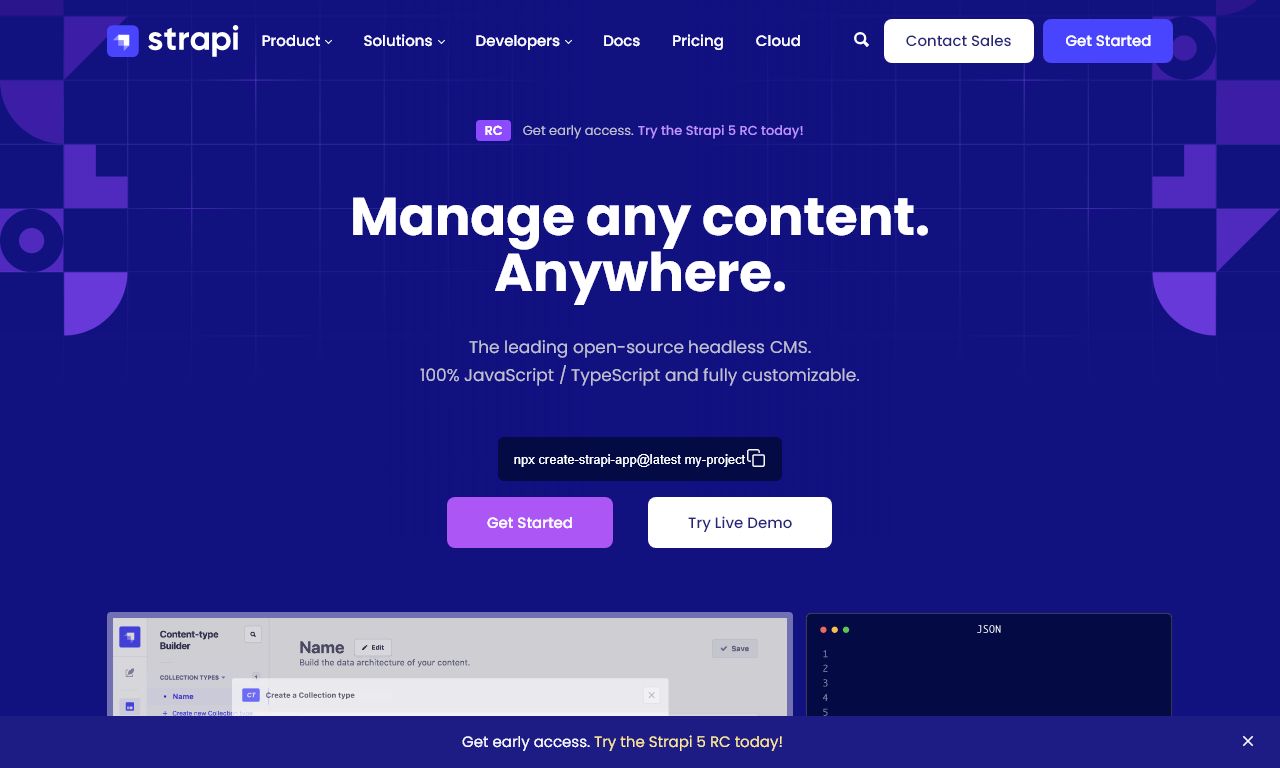
Strapi
Strapi, an open-source headless CMS, offers developers a flexible and customizable content management solution for building modern applications.
This review explores Strapi's features, capabilities, and overall performance as a content management system.
1. Overview and purpose of the CMS
Strapi is a headless CMS designed to provide developers with a flexible backend for managing content across various platforms and applications.
It allows for easy creation and management of content types, APIs, and user roles, making it suitable for a wide range of projects.
Strapi's architecture enables developers to use their preferred frontend technologies while leveraging a powerful content management backend.
2. User interface and ease of use
Strapi offers a clean and intuitive admin panel that simplifies content management tasks.
The user interface is designed with both developers and content creators in mind, providing a seamless experience for all users.
Navigation is straightforward, with a logical menu structure and clear labeling of features and functionalities.
3. Content creation and editing tools
Strapi provides a robust set of content creation and editing tools, including a customizable content type builder.
Users can create and manage various content types, such as articles, products, or custom entities, with ease.
The built-in WYSIWYG editor supports rich text formatting, image embedding, and other essential content creation features.
4. Asset management capabilities
Strapi includes a comprehensive media library for managing digital assets like images, videos, and documents.
Users can upload, organize, and retrieve assets efficiently, with support for various file formats and sizes.
The CMS also offers basic image editing capabilities, such as cropping and resizing, directly within the admin panel.
5. Customization and extensibility options
One of Strapi's key strengths is its high level of customization and extensibility.
Developers can create custom plugins, extend existing functionality, and modify the admin panel to suit specific project requirements.
The CMS supports a plugin system that allows for easy integration of additional features and third-party services.
6. SEO features and optimization tools
Strapi provides built-in SEO optimization tools to help improve content visibility and search engine rankings.
Users can easily manage meta titles, descriptions, and custom URLs for content items.
The CMS also supports the generation of sitemaps and robots.txt files to aid in search engine crawling and indexing.
7. Security measures and user management
Strapi implements robust security measures to protect content and user data.
The CMS offers role-based access control, allowing administrators to define granular permissions for different user groups.
Authentication and authorization are handled through JWT tokens, ensuring secure API access and user management.
8. Performance and scalability
Strapi is designed to deliver high performance and scalability for projects of various sizes.
The CMS uses a Node.js backend, which allows for efficient handling of concurrent requests and quick response times.
Strapi supports horizontal scaling through containerization and can be easily deployed on cloud platforms for improved performance.
9. Integration with third-party tools and services
Strapi offers seamless integration capabilities with a wide range of third-party tools and services.
The CMS provides RESTful and GraphQL APIs out of the box, enabling easy connection to frontend frameworks and other applications.
Popular integrations include authentication providers, email services, and cloud storage solutions.
10. Pricing and support options
Strapi offers a tiered pricing model with both free and paid options to suit different project needs:
- Community Edition: Free, self-hosted solution with basic features
- Bronze Plan: Starting at $29/month for small teams and projects
- Silver Plan: Starting at $99/month for growing businesses
- Gold Plan: Custom pricing for enterprise-level requirements
Paid plans include additional features, priority support, and enhanced security options.
11. Mobile responsiveness and multi-device support
Strapi offers excellent mobile responsiveness and multi-device support for both content creators and end-users.
The admin panel is fully responsive, allowing content managers to work efficiently on various devices, including smartphones and tablets.
Strapi's API-first approach enables developers to create responsive frontends that adapt seamlessly to different screen sizes and devices.
12. Multilingual capabilities and localization features
Strapi provides robust multilingual support for creating and managing content in multiple languages.
The CMS allows users to define locales and translate content items easily, ensuring a consistent experience across different language versions.
Strapi's internationalization plugin simplifies the process of managing translations and locale-specific content.
13. Workflow management and collaboration tools
Strapi includes workflow management features to streamline content creation and publishing processes.
Users can define custom workflows, assign tasks, and set up approval processes for content items.
The CMS supports collaboration through features like comments, notifications, and role-based permissions.
14. Version control and content revision history
Strapi offers version control capabilities to track changes and maintain a history of content revisions.
Users can view and compare different versions of content items, making it easy to revert changes when necessary.
The CMS stores revision history, allowing teams to collaborate effectively and maintain content integrity.
15. Analytics and reporting functionalities
Strapi provides basic analytics and reporting features to help users track content performance and user engagement.
While not as comprehensive as dedicated analytics tools, Strapi offers insights into content views, user activity, and API usage.
Users can integrate third-party analytics services for more advanced reporting and data analysis.
16. E-commerce capabilities
Strapi can be extended to support e-commerce functionalities through plugins and custom development.
While not primarily an e-commerce platform, Strapi's flexibility allows for integration with popular e-commerce solutions like Shopify or WooCommerce.
Developers can create custom content types and APIs to manage product catalogs, orders, and customer data.
17. Compliance with accessibility standards
Strapi is committed to accessibility compliance, aiming to meet WCAG guidelines for both the admin panel and generated content.
The CMS provides features to help developers create accessible content, such as alt text for images and semantic HTML structure.
Strapi's community actively works on improving accessibility features and addressing any reported issues.
18. Documentation and learning resources
Strapi offers comprehensive documentation and learning resources to support developers and content creators.
The official Strapi documentation provides detailed guides, tutorials, and API references.
Additional learning resources include video tutorials, webinars, and a knowledge base for troubleshooting common issues.
19. Community support and ecosystem
Strapi boasts a vibrant community of developers and users who contribute to its growth and ecosystem.
The open-source nature of Strapi encourages community contributions, resulting in a wide range of plugins and extensions.
Users can seek support through community forums, GitHub discussions, and social media channels.
20. Migration tools and processes from other platforms
Strapi provides migration tools and guidelines to facilitate the transition from other content management systems.
The CMS offers documentation on migrating from popular platforms like WordPress, Drupal, and traditional databases.
Strapi's flexible content modeling allows for easy mapping of existing content structures to the new system.
Conclusion
Strapi stands out as a powerful and flexible headless CMS solution, offering a wide range of features and capabilities for modern web development.
With its strong focus on customization, performance, and developer experience, Strapi is well-suited for projects of various sizes and complexities.
As the platform continues to evolve and improve, it remains a top choice for developers seeking a robust and adaptable content management system.
Website:

